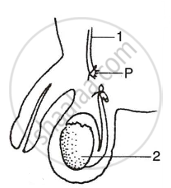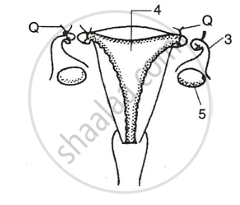Advertisements
Advertisements
प्रश्न
Observe the diagram A and B given below:

- Label parts 1 – 5.
- What does diagram A depict?
- What does diagram B depict?
- What comment on X and Y.
- State one function each of part 2 and 4.
उत्तर
- 1. Vas deferens
2. Testis
3. Oviduct
4. Uterus
5. Ovary - Diagram A depicts vasectomy in males (i.e., cutting and tying the vas deferens).
- Diagram B depicts tubectomy in females (i.e., cutting and typing the oviducts).
- ‘X’ represents the cut and tied end of vas deferens in male. Cutting and tying of vas deferens prevents the passage of sperms and avoids pregnancy. ‘Y’ represents the cut and tied ends of oviducts of female. Cutting and tying of oviducts prevents the passage of ovum and avoids pregnancy.
- Part 2 (Testis) produces sperms (male gametes).
Part 4 (Uterus) carries and protects the foetus till its birth.
APPEARS IN
संबंधित प्रश्न
Tubectomy is performed on females.
How are women operated to prevent the flow of eggs into oviduct?
State two methods of contraception, one a barrier method and one which is not a barrier method. For each method named give two advantages and one disadvantage of the method.
Why are family planning methods not adopted by all the people of our country?
Give the biological term for the surgical method of contraception in human females.
Mention the surgical method of contraception in men.
What are the three aspects covered under family welfare?
IUDs prevent implantation of embryo in vagina.
How can the knowledge of the process of reproduction help people in limiting the size of their families? Give two concrete examples.
Observe the diagrams (A) and (B) given below and answer the following questions.
 |
 |
- Label the parts 1 to 5.
- What does figure A depict?
- What does figure B depict?
- Comment on P and Q.
- Mention one function each of part 2 and 4.
